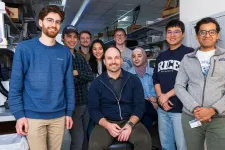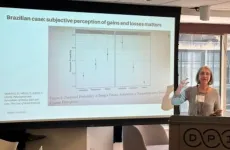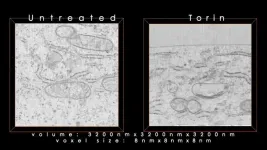(Press-News.org) Finding highlights the importance of including pet-owning households in surveillance programmes for antibiotic resistance
**Note: the release below is a special early release from the ESCMID Global Congress (formerly ECCMID, Barcelona, Spain, 27-30 April). Please credit the congress if you use this story**
**ECCMID has now changed name to ESCMID Global, please credit ESCMID Global Congress in all future stories**
Pet dogs and cats play an important role in the spread of antibiotic-resistant bacteria, new research be presented at the ESCMID Global Congress (formerly ECCMID) in Barcelona, Spain (27-30 April) suggests.
The study has found evidence of multidrug-resistant bacteria being passed between sick cats and dogs and their healthy owners in Portugal and the UK, raising concerns that pets can act as reservoirs of resistance and so aid in the spread of resistance to vital medicines.
Antibiotic resistance is reaching dangerously high levels around the world. Drug-resistant infections kill more than 1.2 million people a year globally and, with the figure projected to rise to 10 million by 2050 if no action is taken, the World Health Organization (WHO) classes antibiotic resistance as one of the greatest public health threats facing humanity.
“Recent research indicates that the transmission of antimicrobial resistance (AMR) bacteria between humans and animals, including pets, is crucial in maintaining resistance levels, challenging the traditional belief that humans are the main carriers of AMR bacteria in the community,” says lead researcher Juliana Menezes, of the Antibiotic Resistance Lab at the Centre of Interdisciplinary Research in Animal Health, Faculty of Veterinary Medicine, University of Lisbon.
“Understanding and addressing the transmission of AMR bacteria from pets to humans is essential for effectively combating antimicrobial resistance in both human and animal populations.”
Ms Menezes and colleagues tested faecal and urine samples and skin swabs from dogs and cats and their owners for Enterobacterales (a large family of bacteria which includes E. coli and Klebsiella pneumoniae) resistant to common antibiotics.
They focused on bacteria resistant to third generation cephalosporins (used to treat a broad range of conditions, including meningitis, pneumonia and sepsis, they are classed among the most critically important antibiotics for human medicine by the World Health Organisation) and carbapenems (part of the last line of defence when other antibiotics have failed).The prospective longitudinal study involved five cats, 38 dogs and 78 humans from 43 households in Portugal and 22 dogs and 56 humans from 22 households in the UK.
All of the humans were healthy. All of the pets had skin and soft tissue infections (SSTI) or urinary tract infections (UTI).
In Portugal, one dog (1/43 pets, 2.3%) was colonised by an OXA-181-producing multidrug-resistant Escherichia coli strain. OXA-181 is an enzyme that confers resistance to carbapenems.
Three cats and 21 dogs (24/43 pets, 55.8%) and 28 owners (28/78 owners, 35.9%) harboured ESBL/Amp-C producing Enterobacterales. These are resistant to third generation cephalosporins.
In five households, one home with a cat and four with dogs, both pet and owner were carrying ESBL/AmpC-producing bacteria. Genetic analysis showed the strains to be the same, indicating that the bacteria passed between pet and owner.
In one of these five households, a dog and owner also had the same strain of antibiotic-resistant Klebsiella pneumoniae.
In the UK, one dog (1/22 pets,14.3%) was colonised by two strains of multidrug-resistant E. coli producing NDM-5 beta-lactamase. These E. coli were resistant to third generation cephalosporins, carbapenems and several other families of antibiotics.
ESBL/AmpC-producing Enterobacterales were isolated from eight dogs (8/22 pets, 36.4%) and three owners (3/24 owners, 12.5%).
In two households, both dog and owner were carrying the same ESBL/AmpC-producing bacteria.
It wasn't possible to prove the direction of transmission, however, in three of the homes in Portugal, the timing of the positive tests for the ESBL/AmpC-producing bacteria strongly suggest that, in these cases at least, the bacteria were being passed from pet (two dogs and one cat) to human.
Ms Menezes, a PhD student, says: “Our findings underline the importance of including pet-owning households in national programmes that monitor levels of antibiotic resistance.
“Learning more about the resistance in pets would aid in the development of informed and targeted interventions to safeguard both animal and human health.”
Bacteria can be passed between pets and humans by petting, touching or kissing and through the handling of faeces. To prevent transmission, the researchers recommend owners practise good hygiene, including washing their hands after petting their dog or cat and after handling their waste.
“When your pet is unwell, consider isolating them in one room to prevent the spread of bacteria throughout the house and clean the other rooms thoroughly,” adds Ms Menezes.
All of the dogs and cats were successfully treated for their infections. The owners did not have infections and so did not need treatment.
END
UK/Portuguese study strongly suggests antibiotic-resistant “superbugs” are being passed from cats and dogs to their owners
Pet dogs and cats in Portugal and the UK were carrying the same antibiotic-resistant bacteria as their owners
2024-04-13
ELSE PRESS RELEASES FROM THIS DATE:
Researchers study effects of solvation and ion valency on metallopolymers
2024-04-12
In a new paper published in JACS AU, researchers at the University of Illinois Urbana-Champaign analyzed the effects of solvation and ion valency on metallopolymers, with implications for critical materials recovery and recycling, and environmental remediation.
Chemical and biomolecular engineering (ChBE) professor Xiao Su led the research, which explored the science behind the selectivity “preferences” of monovalent and divalent anions towards redox polymers. In other words, why – when electrodes are coated with redox polymer films and potential is applied – one ion prefers the redox polymer while ...
Physicists solve puzzle about ancient galaxy found by Webb telescope
2024-04-12
RIVERSIDE, Calif. -- Last September, the James Webb Space Telescope, or JWST, discovered JWST-ER1g, a massive ancient galaxy that formed when the universe was just a quarter of its current age. Surprisingly, an Einstein ring is associated with this galaxy. That’s because JWST-ER1g acts as a lens and bends light from a distant source, which then appears as a ring — a phenomenon called strong gravitational lensing, predicted in Einstein’s theory of general relativity.
The total mass enclosed within the ring has two components: stellar and dark matter components.
“If ...
Clear guidelines needed for synthetic data to ensure transparency, accountability and fairness study says
2024-04-12
Clear guidelines should be established for the generation and processing of synthetic data to ensure transparency, accountability and fairness, a new study says.
Synthetic data - generated through machine learning algorithms from original real-world data - is gaining prominence because it may provide privacy-preserving alternatives to traditional data sources. It can be particularly useful in situations where the actual data is too sensitive to share, too scarce, or of too low quality.
Synthetic data differs from real-world data as it is generated by algorithmic models known as synthetic data generators, such as Generative Adversarial ...
Report finds significant gender and racial inequities in the educational measurement profession
2024-04-12
Washington, April 12, 2024—Gender and racially based employment disparities, differences in perceptions of diversity, equity, and inclusion (DEI), and workplace discrimination remain significant issues in the field of educational measurement, according to a new report supported by the American Educational Research Association (AERA), the National Council on Measurement in Education (NCME), and Women in Measurement (WIM). Educational measurement professionals who work at universities, thinktanks, and other research organizations are ...
University of Houston and Scotland’s Heriot-Watt University forge strategic energy alliance
2024-04-12
HOUSTON, April 10, 2024 - The University of Houston (UH) and Scotland’s Heriot-Watt University (HWU) signed a memorandum of understanding (MOU) today, marking the beginning of their partnership to foster global collaboration in education, research and innovation in the energy sector and beyond.
At the heart of the MoU lies a commitment to advance research that helps society deliver a just energy transition, with a particular emphasis on hydrogen – a critical element in the transition to sustainable energy ...
Rice team demonstrates miniature brain stimulator in humans
2024-04-12
HOUSTON – (April 12, 2024) – Rice University engineers have developed the smallest implantable brain stimulator demonstrated in a human patient. Thanks to pioneering magnetoelectric power transfer technology, the pea-sized device developed in the Rice lab of Jacob Robinson in collaboration with Motif Neurotech and clinicians Dr. Sameer Sheth and Dr. Sunil Sheth can be powered wirelessly via an external transmitter and used to stimulate the brain through the dura ⎯ the protective ...
Jennifer Stinson receives prestigious Barer-Flood Prize in health services research
2024-04-12
Jennifer Stinson a renowned researcher in the field of chronic pain management in children, has received the 2023 Barer-Flood Prize from the Canadian Institutes of Health Research (CIHR).
The prize, named in honour of the first two Scientific Directors of CIHR-IHSPR, Drs. Morris Barer and Colleen Flood, recognizes the highest-ranking senior-career investigator who identifies as a woman, and their research excellence.
Dr. Stinson, a Professor at the Lawrence Bloomberg Faculty of Nursing, Institute of Health Policy, Management and Evaluation, and Temerty Department of Anesthesiology & Pain Medicine, is being acknowledged ...
First insights into the genetic bottleneck characterizing early sheep husbandry in the Neolithic period
2024-04-12
Modern Eurasian sheep predominantly belong to only two so-called genetic matrilineages inherited through the ewes. Previous research thereby assumed that genetic diversity must already have decreased rapidly in the early stages of domestication of wild sheep. Our study of a series of complete mitogenomes from the early domestication site Asıklı Höyük in central Anatolia, which was inhabited between 10,300 and 9,300 years ago, disproves this assumption: despite a millennium of human interference with the keeping and breeding of sheep, mitogenomic diversity remained invariably high, with five matrilineages ...
Theories that explain the crisis in democracy are inadequate for Latin America, experts say
2024-04-12
The theories offered by the dominant literature in political science today to try to explain the sources of the political polarization that has endangered democracy around the world are adequate for the United States and Europe, but do not make sense for the countries of Latin America. For this reason, greater collaboration among political scientists is needed to identify other, more plausible hypotheses for the phenomenon that the region is also experiencing.
The assessment was made by researchers participating in a panel discussion on democracy and social inclusion held on April 9 in Chicago (United States) during FAPESP Week Illinois https://fapesp.br/week/2024/illinois.
“There’s ...
Starving cells hijack protein transport stations
2024-04-12
A new study details how nutrient-starved cells divert protein transport stations to cellular recycling centers to be broken down, highlighting a novel approach cells use to deal with stressful conditions.
New proteins bound for outside the cell are manufactured on the endoplasmic reticulum (ER) – a snaking membrane inside the cell. Grape-like tubular outgrowths on the ER called ER exit sites serve as transport stations, collecting these newly synthesized proteins and delivering them to the next step in their journey.
In recent ...
LAST 30 PRESS RELEASES:
Study links genetic variants to risk of blinding eye disease in premature infants
Non-opioid ‘pain sponge’ therapy halts cartilage degeneration and relieves chronic pain
AI can pick up cultural values by mimicking how kids learn
China’s ecological redlines offer fast track to 30 x 30 global conservation goal
Invisible indoor threats: emerging household contaminants and their growing risks to human health
Adding antibody treatment to chemo boosts outcomes for children with rare cancer
Germline pathogenic variants among women without a history of breast cancer
Tanning beds triple melanoma risk, potentially causing broad DNA damage
Unique bond identified as key to viral infection speed
Indoor tanning makes youthful skin much older on a genetic level
Mouse model sheds new light on the causes and potential solutions to human GI problems linked to muscular dystrophy
The Journal of Nuclear Medicine ahead-of-print tip sheet: December 12, 2025
Smarter tools for peering into the microscopic world
Applications open for funding to conduct research in the Kinsey Institute archives
Global measure underestimates the severity of food insecurity
Child survivors of critical illness are missing out on timely follow up care
Risk-based vs annual breast cancer screening / the WISDOM randomized clinical trial
University of Toronto launches Electric Vehicle Innovation Ontario to accelerate advanced EV technologies and build Canada’s innovation advantage
Early relapse predicts poor outcomes in aggressive blood cancer
American College of Lifestyle Medicine applauds two CMS models aligned with lifestyle medicine practice and reimbursement
Clinical trial finds cannabis use not a barrier to quitting nicotine vaping
Supplemental nutrition assistance program policies and food insecurity
Switching immune cells to “night mode” could limit damage after a heart attack, study suggests
URI-based Global RIghts Project report spotlights continued troubling trends in worldwide inhumane treatment
Neutrophils are less aggressive at night, explaining why nighttime heart attacks cause less damage than daytime events
Menopausal hormone therapy may not pose breast cancer risk for women with BRCA mutations
Mobile health tool may improve quality of life for adolescent and young adult breast cancer survivors
Acupuncture may help improve perceived breast cancer-related cognitive difficulties over usual care
Nerve block may reduce opioid use in infants undergoing cleft palate surgery
CRISPR primes goldenberry for fruit bowl fame
[Press-News.org] UK/Portuguese study strongly suggests antibiotic-resistant “superbugs” are being passed from cats and dogs to their ownersPet dogs and cats in Portugal and the UK were carrying the same antibiotic-resistant bacteria as their owners







